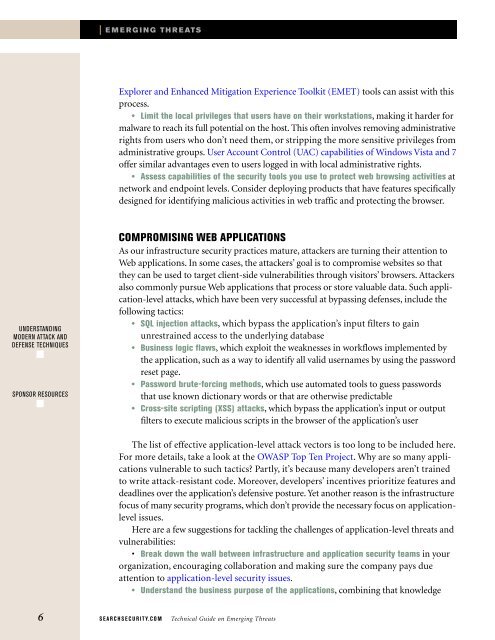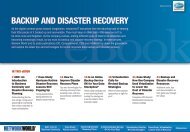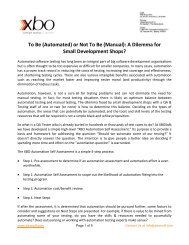Download - Bitpipe
Download - Bitpipe
Download - Bitpipe
You also want an ePaper? Increase the reach of your titles
YUMPU automatically turns print PDFs into web optimized ePapers that Google loves.
| EMERGING THREATSExplorer and Enhanced Mitigation Experience Toolkit (EMET) tools can assist with thisprocess.• Limit the local privileges that users have on their workstations, making it harder formalware to reach its full potential on the host. This often involves removing administrativerights from users who don’t need them, or stripping the more sensitive privileges fromadministrative groups. User Account Control (UAC) capabilities of Windows Vista and 7offer similar advantages even to users logged in with local administrative rights.• Assess capabilities of the security tools you use to protect web browsing activities atnetwork and endpoint levels. Consider deploying products that have features specificallydesigned for identifying malicious activities in web traffic and protecting the browser.UNDERSTANDINGMODERN ATTACK ANDDEFENSE TECHNIQUESSPONSOR RESOURCESCOMPROMISING WEB APPLICATIONSAs our infrastructure security practices mature, attackers are turning their attention toWeb applications. In some cases, the attackers’ goal is to compromise websites so thatthey can be used to target client-side vulnerabilities through visitors’ browsers. Attackersalso commonly pursue Web applications that process or store valuable data. Such application-levelattacks, which have been very successful at bypassing defenses, include thefollowing tactics:• SQL injection attacks, which bypass the application’s input filters to gainunrestrained access to the underlying database• Business logic flaws, which exploit the weaknesses in workflows implemented bythe application, such as a way to identify all valid usernames by using the passwordreset page.• Password brute-forcing methods, which use automated tools to guess passwordsthat use known dictionary words or that are otherwise predictable• Cross-site scripting (XSS) attacks, which bypass the application’s input or outputfilters to execute malicious scripts in the browser of the application’s userThe list of effective application-level attack vectors is too long to be included here.For more details, take a look at the OWASP Top Ten Project. Why are so many applicationsvulnerable to such tactics? Partly, it’s because many developers aren’t trainedto write attack-resistant code. Moreover, developers’ incentives prioritize features anddeadlines over the application’s defensive posture. Yet another reason is the infrastructurefocus of many security programs, which don’t provide the necessary focus on applicationlevelissues.Here are a few suggestions for tackling the challenges of application-level threats andvulnerabilities:• Break down the wall between infrastructure and application security teams in yourorganization, encouraging collaboration and making sure the company pays dueattention to application-level security issues.• Understand the business purpose of the applications, combining that knowledge6SEARCHSECURITY.COMTechnical Guide on Emerging Threats













